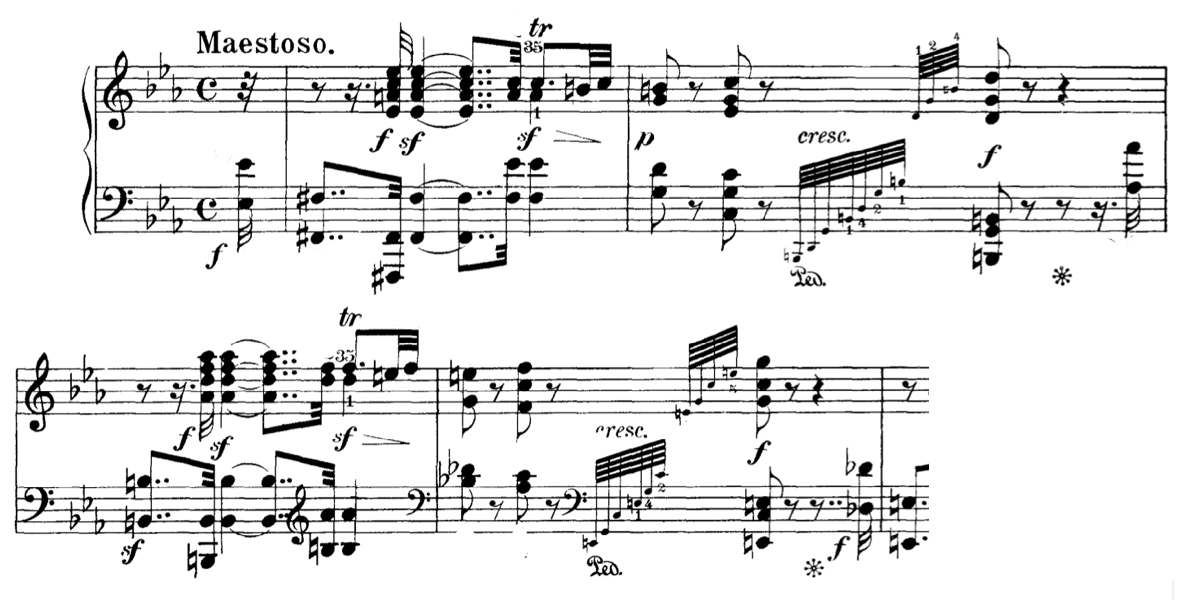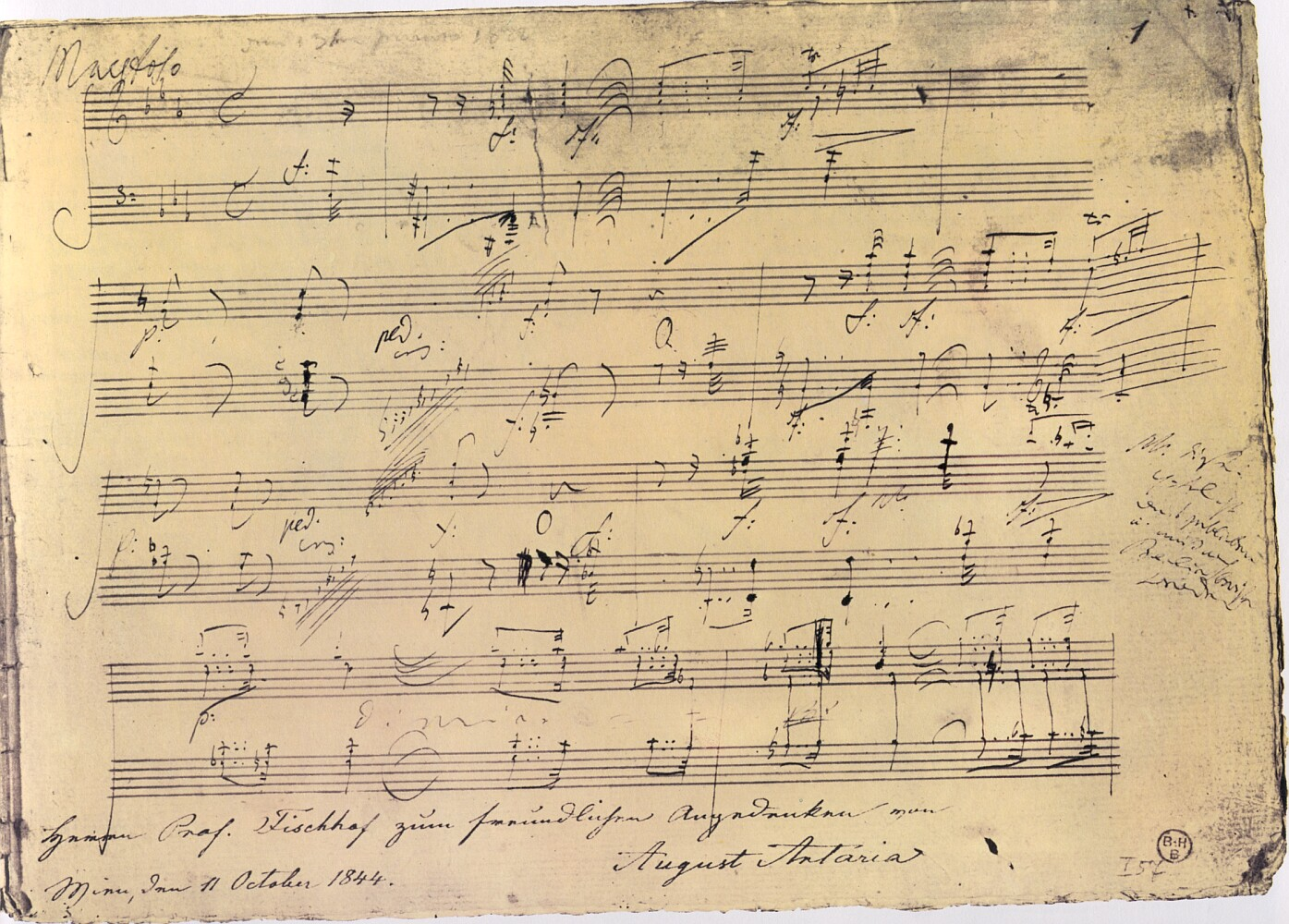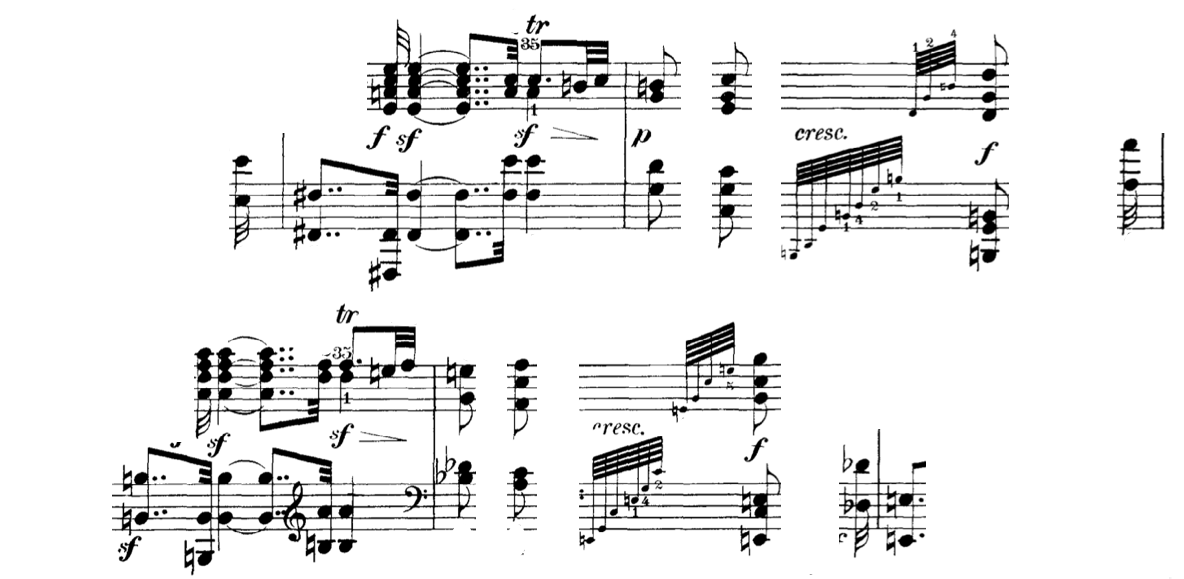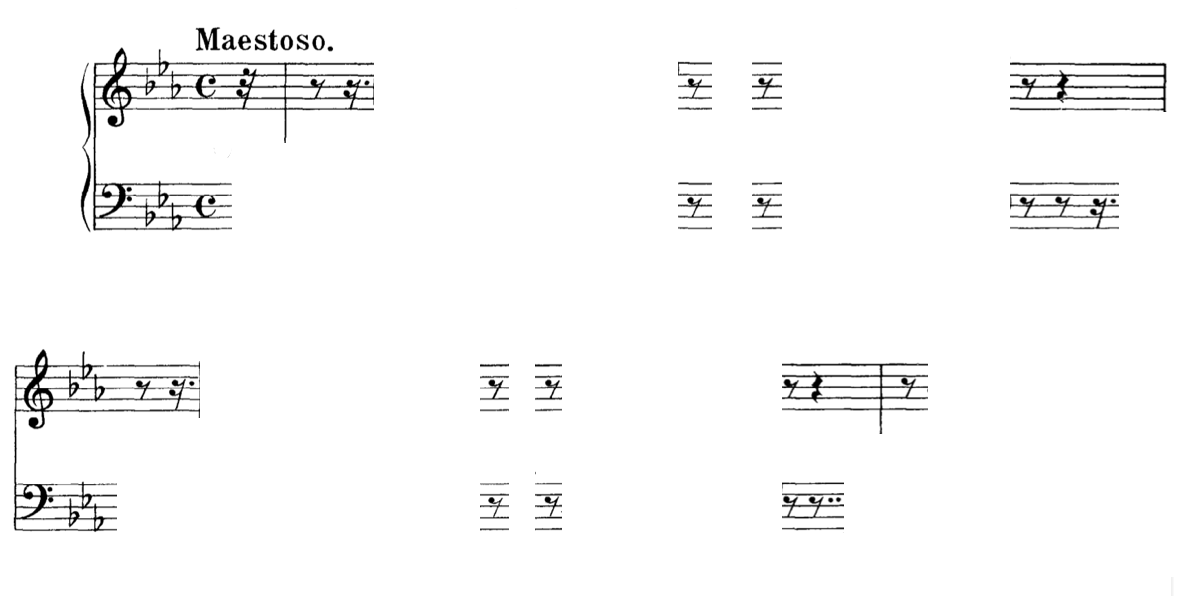Home 1. Introduction 2. Markers 3. Archive 4. Audible Markers 5. Visible Markers 6. Notational Markers 7. Conclusion
5.1. The Sonata 5.2. Examples 5.3. Learning from Embodiments
RELEVANT TERMINOLOGY EMPLOYED IN THIS CHAPTER
Silence is perceived stillness or quietness. There is no true silence, so in in this context, silence means relative or sensed silence.
Performed Silence in music is a rest made visible or audible; the impression of silence created in a performance by the performer.
Rests are written notations that indicate silence, stillness, absence, pulsation, breathing, or non-playing.
Eloquent silence communicates from the performer to the listener; non-eloquent silence might have a functional role, but does not have rhetorical or communicative value in the performance.
Structural silences emphasize the structure of the composition.
Markers are signals used to shift attention and thus impose silence, summon silence, or shape the perception of silence. Markers can also include audience rituals, architectural elements, and other sensory cues which influence our experience of silence. Markers are not exclusive to silence; they can also signal sounds, traditions, behaviors, actions.
Embodiment is the overall collection of active performer movements, gestures, postures, and facial expressions, as well as performer choices such as hairstyle and costume.
Gesture is the movement and alignment of arms and legs, fingers and toes, torso, head, and facial expression, in relation to the instrument.
My dissertation examines how performers engage with the multiple dimensions of musical silence. This chapter will focus on visual embodiments of silence in the concert hall. One particular example will be used as a case study, in which performers embody silence in a precisely notated classical composition.
What does performed silence look like onstage? Can the visual presentation of performed silence be stronger than the auditory? Comparisons in this chapter will illustrate a highly heterogeneous and heretofore undocumented vocabulary for performing silences visually.
The value of looking at silence embodiments is that performers can use multiple gestural vocabularies to enrich their interpretations, while composers may use the same vocabularies to enrich their scoring.
I have selected six well-known pianists and analyzed their performances as a way of understanding embodied silence in classical music: Sviatoslav Richter, Maurizio Pollini, Maria João Pires, Evgeny Kissin, Katie Mahan, and Daniil Trifonov. The selected composition is Beethoven’s last piano sonata, opus 111.
I could have chosen another classical composer or another silence from another sonata. I state that this might have given similar results in terms of illustrating embodied silences. I have focused very narrowly on the first four bars of the sonata. But this by no means covers all the compelling silences of the piece. I could have chosen the in-between silence before the second movement, which suggests a Cagean stasis, or the silence at the end of this sonata, which calls forth “a silence […] more important than the sound that preceded it” (Brendel, 1976, p. 53). The point is not so much the particular silence chosen, but rather its affordances as a vehicle for examining diverse embodiments.
Opus 111 is a technically demanding work with a strong history, performance practice, and even a mythology. The pianistic challenge has inspired its own literature and legends, most notably through Doctor Faustus, in which Thomas Mann describes a performance of this sonata by a fictional pianist.1
Boom, boom—voom, voom—throom, throom—he struck the grimly vehement opening accents of the first movement, and in a high falsetto he sang along with passages of melodic sweetness, which, like delicate glimpses of light, now and then illuminate the storm-tossed skies of the piece. (Mann, 1947, p. 58)
For Mann, the work seems to begin in grimly vehement conflict, heightening the eloquent possibilities of the rests around the fanfares. This striking, storm-tossed realm of gestural activity will distinguish the Beethoven examples starkly from the static, non-narrative poses and attitudes of the Cage examples.
Despite the dramatic pauses that open the first movement of the Beethoven, most of the sonata is one long continuous phrase. It is a composition with very few rests, thus making the ones that exist all the more noteworthy. Those initial rests are framed by dramatically powerful notes. The first two short rests serve as gasps during the fanfares. The fanfares themselves are framed by longer rests, which offer a rich variety of interpretations.
Figure 1: first four bars of Beethoven’s opus 111 piano sonata, illustrating the two fanfares (Edition Peters: 1974)
Punctuated by the rests, the two first lines separate clearly into two fanfares. From a functional point of view, perhaps the short silences during each fanfare invite the listener to experience retrospective understanding, a type of backward hearing. Or they might be punctuation, miniature commas indicating breathlessness. The rests after the rising arpeggios might also indicate stopping, finality, a structural marker for the audience’s understanding of the form. They could be merely a temporary interruption or an anticipative signal to restart the sonata in a different key. Depending on the assumed meaning, pianists will interpret them differently. However, as music philosopher Jerrold Levinson discusses in “Performative vs. Critical Interpretation in Music”, there is no direct and unambiguous relation between the way performers understand a piece and the way they perform it. In other words, the same meaning can lead to different interpretations, while the same interpretation can be grounded on different analyses of a piece. And each pianist can and will interpret the silences in a musical work differently, also because the notation of the rests remains simple and unidimensional, as discussed in Chapter 2.
As a student, I was barely aware of this potential richness. I did not pay any attention to these rests, and I certainly did look for the eloquence of silences. I tended to rush through the rests to get to the exciting notes in the next fanfare of opus 111. As I began performing the work in concerts, and as my knowledge of the score improved, I started to hear the power of the silences, particularly after the arpeggi. I discovered that they could be used to gauge the acoustics in the hall; they offered a listening opportunity for the performer. This insight was the moment when I first began to experiment with performed silence.
Perhaps Beethoven even considered this possibility. Note the discrepancy in the score between the notation of the rests after the arpeggi and the pedal release: according to Beethoven’s manuscript (see figure 2) and the published score (see figure 1), the pedal is released an eighth note later than the hands at 1F and 2F. This creates ambiguity: Beethoven’s pedal-off is deliberately notated during a rest. Does he want the pianist to sustain the notes partially through the rest? Does he want to suggest a diminuendo of the post-arpeggio chord? In a large concert hall, this effect would occur naturally without the pedal: the acoustic reverberation would gradually diminish, as Beethoven would have known. Yet, in a drier environment, the pedal might be necessary. I see this potentially as permission to explore the acoustic possibilities of the rest, an invitation to present an eloquent silence that could be either connective or dis-connective. Separative rests (“nots”) offer heightened articulation for the structure of the sonata, creating interruptions and divisions. Conversely, connective rests (“knots”) tie phrases or notes together, continuing the musical line and uniting disparate elements. Connective rests can also articulate the structure, but they do so more subtly.
Figure 2: Beethoven’s autograph manuscript from 1844, showing the opening bars of opus 111 (Beethoven-Haus, Bonn)
My youthful exploration of the acoustic via the rests has precedents. Listening to the reflections of the architecture is indeed one motivation for performing silence, one that relates to the lengthy spaces of ma in the pauses of some of Morton Feldman’s pieces, or to compositions of John Adams or Arvo Pärt or performances of Alvin Lucier that explore physical space through sound (and often silences).
RELATED ITEM: Respect the Rest (an experimental video) based on opus 111 silences as performed by famous pianists
On the printed page, the rests have a clear, unambiguous performance instruction, namely to refrain from pushing any key for the specified duration. As discussed in Chapter 2, the written rests contain very little further information.
In performance, the rules change: the rests gain communicative power through performed embodiments (see Barthes, 2005, p. 26).2 The performers whom I will analyze in more detail below all use gestural markers to create silence captions.
Indeed, the fanfares of dramatic notes are alternated in their performance with embodiments of even more dramatic rests. The constant presence of embodied markers in the performances of these six pianists suggests that context and captions are essential.3 As the examples may show, the notated rests rarely lead to silence; they are often used as a permission to depart from the score: to leave the keyboard, to go away from the keys. The rests offer remarkable performative freedom: to perform silence, to dramatize silence, to extend the resonance, or (in some cases) to avoid silence entirely. Indeed, what the analysis of these examples may reveal is how wide the gap is between the simple rests on the page and the incredibly diverse and eloquent embodiments illustrated onstage.
In what follows, I intend to examine neither the intentions of the composer nor the composition itself, but rather the contemporary visual embodiments of notated silences. These will be illustrated by a group of six star pianists found on YouTube. In these videos, viewers experience Beethoven’s rests through many influential markers: the acoustics, the size and type of the concert hall, the décor, the performer’s clothing, the program notes or lack thereof, the audience’s attentiveness, the cultural rituals surrounding the performance, and the type of piano. These markers affect the performance and the experience of silences (and notes), and all deserve (and have received) serious coverage and discussion in my work and elsewhere.4 But I will mostly exclude them from the present chapter so as to focus on visible embodied markers.
Like any instrument, the piano extends the performer’s body. But a grand piano is a heavy machine enclosed in a massive wooden box.5 Unlike a violin or flute, the external body of the instrument offers no moving extension of the performer’s body. As Cobussen mentions, it can also provide resistance: “This struggle, this resistance, this strife, is mainly of a physical nature, deriving from the instrument’s materiality and its interaction with the musician’s flesh” (Cobussen, 2017, p. 122). Many of the archive examples that were composed for me engage the question of resistance metaphorically.6
Moreover, classical conventions impose gestural limitations. No classical pianist would attack the keys with their feet or butt, even though rock ‘n roll pianist Jerry Lee Lewis became famous for just such embodiments.
So, the pianist’s behavior and embodiment of silence are limited by the socio-cultural rituals of the concert hall, instrumental resistance, and the need to keep both hands on the keyboard most of the time.
Pianists perform silence via embodiments, which can be gestures of hands, arms, legs, backs, and necks; facial movements, grimaces, frowns, closed eyes; shakes of the head or hair tossing; and many other gestures, small and large.
To better understand the repeated gestures of the pianists I have analyzed, I wanted to re-repeat them in a process of reflective imitation. I attempted to duplicate the most remarkable embodiments, playing the same phrasing, copying the same gestures, and filming myself again and again in an exercise of learning through reflective imitation. Each of the examples will end with a video in which I learn at the piano from the pianist’s style, embodiments, and physicality.
This method contains both benefits and conflicts. The major conflict is one of bias. In order to effectively imitate a conservatory-trained concert pianist, one must have undergone similar training oneself over many years (Lüneburg, 2023; Lüneburg & Ciciliani, 2021). A dispassionate outside perspective is thus almost impossible to achieve. A second flaw is discipline. A dancer or actor will be well-schooled in imitation, especially gestural imitation, whereas concert pianists are discouraged from imitation starting at the earliest age. I have had no training in imitation as a bodily method, a gap that will be abundantly clear to those who watch my videos.
Yet the benefits of the method are also clear and do justify the inclusion of my exploratory videos. Aside from documenting my working process, one which evolves directly from and through my practice, these videos offer discoveries. Speaking of a similarly personal process of understanding through (re-)interpretation, pianist and scholar Anna Scott writes:
This understanding is a rich one however, in that performance elements are perceived, deciphered, translated, and become linked to one another, through one’s own mind and body as a performer. What is at first only sensed becomes clumsily enacted: an experience that begets enhanced understanding, more focused movements, and so on. (Scott, 2014, p. 183)
The personal learning involved in re-repeating (Schechner, 2013), re-enactment (Lüneburg, 2023), or reflective imitation does not enable me to become Richter, but with each enactment, however clumsy, I learn, sense, and understand slightly more from Richter through a tactile and audible embodiment.
Watching myself working through these videos as if I were another body and another pianist taught me a great deal. This embodiment of performers who were already themselves embodying something (whether the “lonely prince,” Beethoven, their stage persona, or their emotional idea of the music) created an overlay of fictionalizations, sometimes highlighting the quirks or eccentricities of the performers and other times illuminating new ideas about performing. By “re-repeating” these performed silences, I began to notice that the visual seemed to have weight, sometimes even outweighing the audible. I also understood better how some pianists made the silences separative, and others used them to knot together the two fanfares that open the sonata.
[…] the communicative rest almost always has more than one potential function, which the performer is at liberty to reveal or create. (Potter, 2017, p. 168)
The rests offer a creative and performative scope to the performers that can be interpreted as a permission from the composer, a permission that is not easily granted when performing the notes: the pianists whom I have studied in detail are at liberty to make the silences visible. Their silence gestures form a tacit vocabulary that becomes part of the music communicated to the audience. These performers have adopted a range of stylized and often wild gestures to mark the opening silences. Yet their embodiments mostly remain undocumented in studies of this composition: transgressive, messy, fleshy, and bodily gestures are hiding in plain sight.



